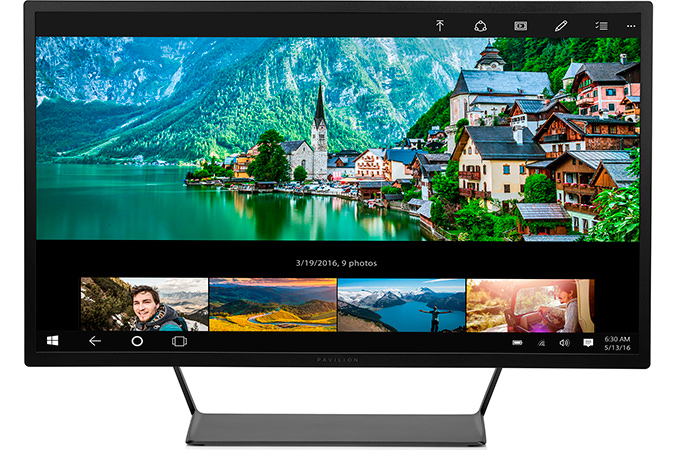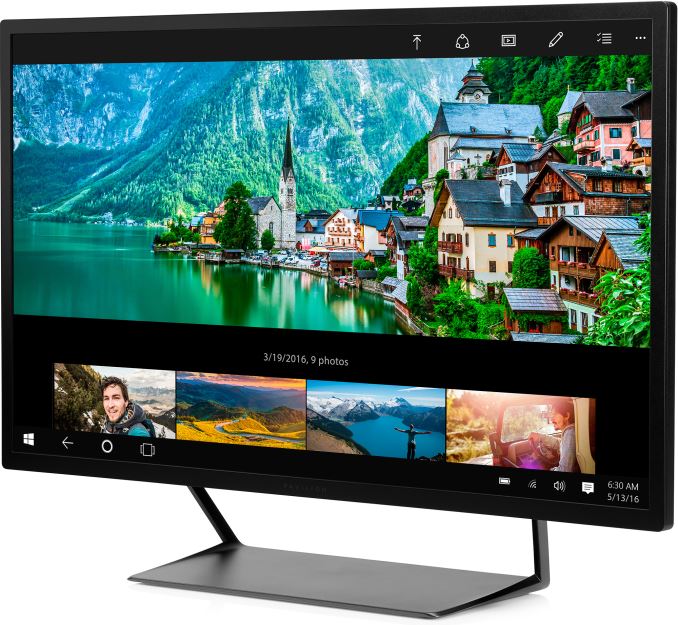HP Announces 32” Pavilion Display for Everyone: QHD for $399
by Anton Shilov on May 4, 2016 11:05 AM EST
HP has introduced its Pavilion 32 display (V1M69A), which promises to combine large size, QHD resolution, VA panel and affordability. The Pavilion 32 monitor may not appeal to professionals or hardcore gamers, but for mainstream users this one could be a game changer because of its price-point. The monitor will hit the market late next month as a part of HP’s back-to-school product refresh.
Modern day desktop workloads involve a lot of multitasking as well as long documents, large spreadsheets and high-resolution images. For many tasks, big displays are not a luxury, but rather a necessity. However, it is not easy to find a monitor that boasts with a large size, a good quality panel and an affordable price. There are relatively inexpensive 24” and 27” monitors with IPS or VA panels available, but when it comes to models with diagonals like 30” and larger, then it is not easy to find a good quality affordable display. While there are low-priced 32” monitors from unknown brands, they usually feature cheap TN panels and can hardly boast with good quality. Meanwhile, well-known suppliers charge $500 and up for their 32” models, which is more than many people are willing to spend on a display. With its Pavilion 32, HP wants to address the market of affordable monitors with an offering that is currently not available from its rivals.
The HP Pavilion 32 (V1M69A) display uses a 32" WVA+ panel with 2560×1440 resolution, 300 cd/m2 brightness, 3000:1 static contrast ratio, 178°/178° horizontal/vertical viewing angles as well as 60 Hz refresh rate. WVA stands for wide viewing angle, which is a general term to describe various types of panels (including *VA and PLS) used by display makers in their products. HP does not disclose exact type of the panel that powers the Pavilion 32”, but confirms that this is a VA panel (though, we have no idea whether this is AH-VA, A-MVA, etc.), not a TN (which is typically used for low-cost displays). In many ways, the Pavilion 32 resembles the Envy 32 monitor, which HP introduced several months ago. The Envy 32 has a similar WVA+ panel, but features stereo speakers as well as AMD’s FreeSync to appeal to gamers, but it is also more expensive.
| Specifications of HP Pavilion 32 and HP Envy 32 | ||||
| HP Pavilion 32 V1M69A |
HP Envy 32 N9C43AA |
|||
| Panel | 32" WVA+ | 32" WVA+ with Anti-Glare | ||
| Resolution | 2560 × 1440 | |||
| Refresh Rate | 60 Hz | 60 Hz with AMD FreeSync | ||
| Response Time | 7 ms gray-to-gray | |||
| Brightness | 300 cd/m² | |||
| Contrast | 3000:1 | |||
| Viewing Angles | 178°/178° horizontal/vertical | |||
| Color Saturation | 100% sRGB | |||
| Pixel Pitch | 0.276 mm | |||
| Pixel Density | 91.8 pixels per inch | |||
| Inputs | 2 × HDMI 1 × DP 1.2 |
1 × HDMI 1 × MHL 1 × DP 1.2 3.5 mm stereo-in |
||
| USB Hub | 2-port USB 2.0 hub | |||
| Audio | None | Stereo speakers with Bang & Olufsen enhancements |
||
| Launch Price | $399.99 | $499.99 | ||
The new Pavilion 32 display from HP is equipped with two HDMI and one DisplayPort 1.2 connectors (cables are included in the package). In addition, it has an integrated USB 2.0 hub, which should be enough to connect a keyboard, but which will not be sufficient for modern external USB flash memory drives that support USB 3.0 transfer rates. Keeping in mind that the hub is located on the backside of the monitor, it looks like it was not intended for removable storage in general. The design of the Pavilion 32 allows adjusting tilt, but not height. Asides from that, the monitor cannot be used in portrait mode, which is hardly a problem for the vast majority of its potential buyers.
Select retailers as well as HP’s online store will start to sell the HP Pavilion 32 on June 26 for $399.99. The monitor is covered by a one- or three year-limited warranty.
The key selling points of the HP Pavilion 32 are its relatively low price as well as its VA panel. Right now, the majority of 32” displays with QHD resolution from well-known suppliers cost over $500. By making its product available for $400, HP appeals to a broader audience of users, who currently buy smaller monitors. What remains to be seen is whether other display makers follow HP with their inexpensive 30” QHD parts.
Source: HP











74 Comments
View All Comments
JoeyJoJo123 - Thursday, May 5, 2016 - link
@Mondozai>I grew up in an age of YouTube. Therefore, all my firsthand learned knowledge comes from YouTube and I am always correct and win all internet arguments.
althaz - Thursday, May 5, 2016 - link
He's also correct. Before Youtube was 16:9 (which it is now, videos that aren't look very out of place), they didn't have 240p/360p/480p (all of which are 16:9 resolutions, btw, though the definitions for them could ) as options - their first quality options didn't directly mention resolution at all.Factory Factory - Friday, May 6, 2016 - link
The "p" in 1080p &c come from digital video production standards. 720p is 720 vertical lines, progressive scan. 1080i is 1080 vertical lines, interlaced scan. The full standard also defines frame or field rate (frames for progressive, fields for interlaced), e.g. 1080p30 or 720i50.As Official Standards From TV People it's just 480, 576, 720, 1080, plus i or p and a frame/field-rate. As a matter of trademark/marketing, only 1080p (a.k.a. FHD/Full HD) and 720p (HD) ever gained significant foothold in terms of mindshare. But it's trivial to extend this naming scheme to other resolutions, and virtually all computer images will be p-for-progressive. So 1440p and 1600p "work." They're just not rigidly defined.
Plus, of course, vertical-progressive shorthand leaves out differing aspect ratios with the same vertical measurements, like you could describe 3440x1440 ultrawide monitors as "1440p". The reason why 1080p is generally unambiguous to mean 1920x1080 rather than, say, 2560x1080, is because 1080p is a defined and trademarked thing.
Samus - Friday, May 6, 2016 - link
I appreciate his passion for 16:10 but these monitors are consumer class displays. 16:10 is reserved for professional and some prosumer displays. It's almost impossible to find a modern 16:10 display for under $1000 let alone something in the 30" class would cost you $2000. These cost a quarter that much.Margalus - Saturday, May 7, 2016 - link
I see a lot of 4:3 videos on youtube, along with other strange aspects. It is definately not all 16:9tamalero - Monday, May 9, 2016 - link
id say different standards.like those old VESA and VGA standards vs the new ones.
Mr Perfect - Thursday, May 5, 2016 - link
The P just means it's progressive scan, rather then I for interlaced scan. They don't have any bearing on aspect ratio.IMO it's actually kind of silly to append the P on everything, you'd be hard pressed to find an interlaced desktop monitor.
JoeyJoJo123 - Thursday, May 5, 2016 - link
It's not just the desktop monitor, but the video output devices as well. Some devices can do 720p or 1080i, for example, and while desktop monitors will perform deinterlacing, it does add additional processing time for the monitor (meaning lag).The interlaced and progressive initials still mean something in certain applications. It's not as important to consumers as it was 10 years ago, but still needed in an age where not all devices output or display progressive scan for every resolution they support.
TheoLu - Friday, May 6, 2016 - link
The 'p' is simply from 'progressive(-scan)' and isn't specific to 16:9 resolutions. Back in the early 2000s when graphics cards with video capture capability were all the rage and 16:9 on computers was still practically unheard of the capture resolutions were generally still only listed, if in a short version, by their vertical resolution.They're not wrong in listing '1600p'.
https://en.m.wikipedia.org/wiki/480p
DanNeely - Wednesday, May 4, 2016 - link
1600p was used as shorthand for 2560x1600 displays before anyone started selling 2560x1440 ones.Thank you, try again.